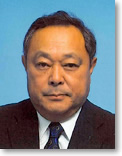
National Organizing Committee, Japan (NOC)
Momoki Katakura, NOC Chairman

Welcome to the 10th International Energy Agency (IEA) Heat Pump Conference 2011.
The Great Eastern Japan Earthquake (a massive earthquake and one of the worst tsunami in history) struck Japan. Since the crisis, we have received countless heartwarming messages of sympathy and support from all over the world, and I would like to express my sincere appreciation to all the people of the world for their kindness and support. Due to the aftereffects of the Great Eastern Japan Earthquake, we cannot get together in Japan at the 10th IEA Heat Pump Conference 2011. In solidarity with the countries of the world as a strong source of support, we intend to work tirelessly toward rebuilding, and we hope to have an opportunity to welcome you to the IEA Heat Pump Conference in Japan sometime soon.
Global warming is one of the most important issues facing humankind. As exemplified by an agreement reached to develop a report on internationally supported mitigation actions by developing countries at the 16th session of the Conference of the Parties (COP 16) to the United Nations Framework Convention on Climate Change, which was held in Cancun, Mexico, last December, active discussions have been taking place on a global scale as to how best to promote measures to cope with global warming.
Given such circumstances, the aggressive pursuit of energy conservation through the introduction of high efficiency devices on the demand side, as well as power generation from renewable energy sources, will become key pillars in combating global warming going forward. Cooling and heating demand to support our everyday lives and industrial activities is the greatest source of energy consumption. Heat pumps should play an extremely important role in meeting cooling and heating demand as they are capable of substantially reducing carbon dioxide (CO2) emissions.
Heat pumps are extensively used for a wide variety of purposes, including freezing, refrigeration, air conditioning, and water heating. A variety of impressive technological innovations have been achieved in heat humps in recent years, thereby making it possible to dramatically improve the efficiency and performance of heat pump equipment. Combustion-based devices were predominantly used for hot water heating and hot water supply for residential use, as well as for heating, drying, and steam generation for industrial use, but with the technological innovations, heat pumps have come to be more extensively used both for residential and industrial applications.
Aerothermal, geothermal and hydrothermal energy, which are used by heat pumps, are defined as renewable energy sources like solar energy in the EU Renewable Energy Directive, as well as in the law entitled Sophisticated Methods of Energy Supply Structures and the Basic Energy Plan in Japan. The increasingly wider use of renewable energy sources by heat pumps can further contribute to a substantial reduction in CO2 emissions.
At the same time, when attempting to substantially reduce the CO2 emissions associated with energy consumption by using high-efficiency heat pumps, it is also necessary to reduce the effects of global warming due to the greenhouse gas emissions from the refrigerant used in heat humps. We consider it essential to not only promote the widespread use of heat pumps but also enforce stricter controls over refrigerant emissions and step up the development of low global warming potential (GWP) refrigerant devices.
The subtitle of the 10th IEA Heat Pump Conference 2011 is "Heat Pumps – The Solution for a Low Carbon World." We look forward to finding a better way to further promote the use and improvements of heat pumps through a variety of discussions on heat pumps, which are a core technology in reducing CO2 emissions, from a variety of perspectives including technology, development, policies, and marketing.
Momoki Katakura
Chairman, National Organizing Committee of the 10th IEA Heat Pump Conference 2011



